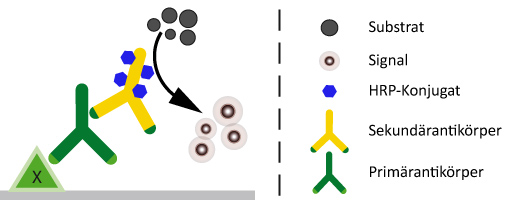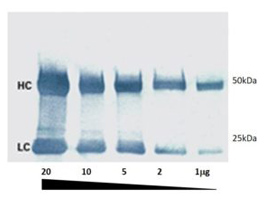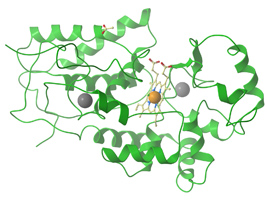
Horseradish Peroxidase (HRP) belongs to the group of metalloenzymes and is industrially produced from the root of horseradish (Armoracia rusticana). HRP-conjugated secondary antibodies from Jackson ImmunoResearch are made following a modified protocol of Nakane und Kawaoi (1974). The small peroxidase (40 kDa) is a much used reporter molecule in immunoassays (Western Blot, ELISA, Immunohistochemistry) and normally coupled in a ratio of 4:1 to secondary antibodies. The rather small size of HRP-conjugates enables good antibody penetration of tissue samples and makes it the most used enzyme for Immunohistochemistry (IHC) on formalin-fixed, paraffin-embedded (FFPE) tissue.
Horseradish Peroxidase contains a heme group with a catalytic ferric iron (FE(III)) within the porphyrin ring and two calcium-atoms (Ca2+). Various substrates can be used for the peroxidase catalyzed redox-reaction, fluorescent or colored reaction products allow an easy detection of antigens (see table).

Heavy- (HC 50kDa) and light-chain (LC 25kDa) of reduced SDS-denatured mouse IgG. Goat IgG anti-Mouse IgG (H+L)-HRP and TMB substrate have been used for visualization. (Image: Jackson ImmunoResearch)

Crystal structure of horseradish peroxidase at 1.57Å from PDB 1HCH. This figure shows two calcium molecules (grey spheres) and the catalytic ferric ion (orange sphere) within in the porphyrin ring. (Image: Jackson ImmunoResearch)
Commonly used substrates:
| Substrate | colour of precipitate |
| DAB (3,3′-Diaminobenzidin) | brown |
| AEC (3-Amino-9-ethylcarbazol) | red-brown |
| TMB (3,3′,5,5′-Tetramethylbenzidin) | dark blue |
You can find chromogenes and substrates here.
IMPORTANT INFORMATION:
Endogenic Peroxidases
Some tissues contain endogenic, peroxidase-like proteins that react with HRP-substrates. This can cause unspecific background staining. We recommend to block those enzymes with hydrogen peroxide (H2O2) before staining, leading to a clear and intense signal.
Reagents compatibility
- Sodium Azide can inhibit horseradish peroxidase activity, addition to antibody solution should be avoided
- Glycerol can inhibit HRP activity. If addition of glycerol is required to prolong shelf life, only ultrapure Glycerol should be used. Learn more about secondary antibody storage in our FAQ.
References:
- Jackson ImmunoResearch: Catalogue 2019
- Veitch, N. C. Horseradish peroxidase: a modern view of a classic enzyme. Phytochemistry 65, 249–259 (2004).
- Jackson ImmunoResearch: Chromogenic Detection for Western Blot, IHC, and ELISA (Jul 13 16)
